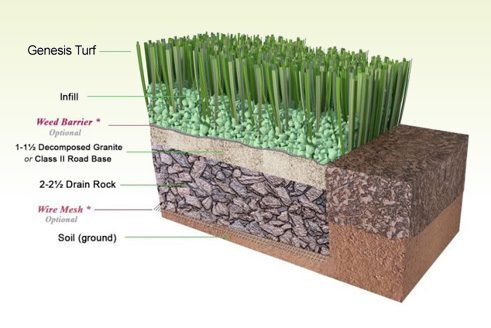Budget-Friendly Turf Installation Phoenix AZ for a Hassle-Free Lawn Option
Budget-Friendly Turf Installation Phoenix AZ for a Hassle-Free Lawn Option
Blog Article
Delve Into the Environmental Benefits of Opting for Synthetic Grass Solutions
The adoption of synthetic turf remedies presents a compelling opportunity to resolve pressing ecological difficulties. By dramatically reducing water usage and lessening the application of hazardous chemicals, these options not just promote lasting landscape design but likewise protect regional ecological communities.
Water Conservation Benefits
One of the most significant advantages of artificial lawn is its capability to save water. In comparison, synthetic turf does not require watering, substantially reducing the general demand for water sources.
By eliminating the requirement for regular watering, synthetic grass contributes to lasting landscape methods and aids reduce the environmental impact of extreme water consumption. In addition, the conservation of water reaches the reduction of runoff, which can result in dirt disintegration and waterway pollution.
Additionally, the setup of synthetic grass permits house owners and districts to allocate water resources a lot more successfully, concentrating on necessary usages such as drinking water and farming. The change in the direction of artificial lawn not just advertises responsible water usage but likewise straightens with more comprehensive environmental objectives focused on preserving natural resources.
As neighborhoods increasingly focus on sustainability, the water preservation advantages of synthetic grass present a compelling situation for its fostering in household and industrial landscape design tasks.
Reduced Chemical Use
The transition to synthetic grass substantially reduces the dependence on chemical treatments commonly used in natural grass maintenance. Typical grass monitoring typically involves the application of pesticides, fertilizers, and herbicides to promote growth and control parasites. These chemicals can present dangers to human health and wellness, neighborhood wild animals, and the atmosphere, adding to dirt and water contamination.
In comparison, synthetic lawn removes the need for these hazardous materials. By reducing the release of synthetic compounds right into the community, fabricated turf advertises healthier dirt and water systems.
Moreover, the absence of chemical drainage connected with synthetic grass installments assists safeguard neighborhood rivers from pollution, supporting water life and maintaining biodiversity. Arizona turf. As communities significantly focus on lasting methods, selecting synthetic grass provides a viable service that aligns with environmental preservation goals. Via this shift, residential property owners can appreciate lush eco-friendly rooms without compromising environmental health, leading the way for a more sustainable future
Reduced Carbon Footprint

Additionally, the setup of synthetic grass can result in significant water conservation. Natural yards call for substantial quantities of water for watering, which not just includes in the carbon footprint related to water removal and treatment however additionally pressures neighborhood water sources. In contrast, synthetic grass needs very little upkeep, requiring no watering, thus significantly reducing water usage and its associated energy useful link expenses.
Furthermore, the durability of synthetic grass adds to its decreased carbon effect. With a life expectancy of as much as 15 years or even more, the requirement for regular replacements is diminished, resulting in much less waste and reduced energy usage in manufacturing and taking care of conventional yard options. On the whole, synthetic grass presents a sustainable alternative for ecologically conscious landscape design.
Environment Conservation
Habitat conservation is a vital consideration in the argument over landscape design selections, especially when contrasting man-made turf to all-natural lawn. Natural grass yards usually need substantial maintenance, including making use of chemicals, plant foods, and herbicides, which can adversely influence regional communities. These chemicals can leach into the dirt and waterways, hurting native plants and animals and interrupting neighborhood habitats.
Fabricated lawn eliminates the requirement for unsafe chemicals, thus securing close-by wild animals and preserving the stability of surrounding communities. The setup of man-made grass can lead to the conversion of previous yard locations right into even more biodiverse landscapes, such as pollinator gardens or native plant areas, which can support regional wildlife.
Ultimately, the shift to fabricated lawn not just saves water and minimizes maintenance efforts however also fosters an extra harmonious connection between human activities and the native environment, advertising habitat preservation while doing so.
Long-Term Sustainability
Long-term sustainability is a vital consider examining the benefits of synthetic turf over typical lawn yards. Among one of the most significant advantages of fabricated turf is its longevity; it can last approximately 15-20 years with very little maintenance, whereas all-natural turf calls for constant reseeding and substitute. This durability lowers the need for consistent resources, such as water, plant foods, and pesticides, which are essential for keeping a healthy yard lawn.
Furthermore, synthetic grass adds to a decrease in carbon Recommended Reading discharges linked with yard care devices. Traditional yards usually call for gas-powered mowers, leaners, and blowers, every one of which add to air pollution. Artificial turf companies phoenix. On the other hand, synthetic grass eliminates the need for such equipment, promoting a cleaner setting
Furthermore, the manufacturing of synthetic grass significantly utilizes recycled materials, boosting its sustainability profile. As producers take on environment-friendly practices, the environmental footprint of synthetic grass proceeds to diminish.

Final Thought
The adoption of fabricated grass solutions provides considerable ecological benefits, consisting of significant water preservation, decreased dependence on hazardous chemicals, and a reduced carbon impact. Man-made turf aids in protecting all-natural environments by decreasing land disturbance and advertising long-lasting sustainability with the usage of resilient products. Jointly, these elements underscore the possibility of synthetic grass to contribute positively to ecological health and supply a feasible choice to traditional landscaping methods in a progressively resource-conscious globe.
In contrast, man-made lawn does not need watering, dramatically minimizing the total need for water sources. By minimizing the release of synthetic substances into the ecological community, man-made turf advertises much healthier soil and water systems.
Moreover, the setup of man-made turf can result in considerable water preservation. In comparison, artificial turf needs very little maintenance, needing no watering, therefore considerably decreasing water usage and its connected energy costs.

Report this page